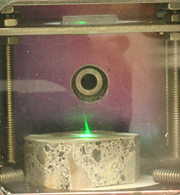- Number 311 |
- May 10, 2010
Laser "steam-cleaning" could help U.S. respond to terror attack

Laser light plays across a
piece of cement spiked with
chemical agent, creating a
green “flame” of vapors and
surface plasma.
If terrorists ever pull off a chemical or "dirty bomb" attack on American soil, quickly and efficiently cleaning up the contamination would be critical. But cement and brick are difficult to clean because contaminants start inhabiting cracks and pores. And the longer buildings, bridges and roads are closed, the greater the disruption to American lives and the U.S. economy. Chemists at DOE's Idaho National Laboratory believe lasers could play a big role in minimizing such disruptions. The researchers are showing that lasers could help scrub chemical- and radiation-contaminated surfaces clean, returning life to normal as safely and smoothly as possible. Laser light can destroy many chemical agents outright. And laser pulses can flash the water inside cracks and pores into steam, carrying radiological contaminants back to the surface for removal. Such laser decontamination is still in the proof-of-principle stage, but the technique shows great promise in the fight against terrorism.
[Michael Wall, 208.526.0490,
michael.wall@inl.gov]
